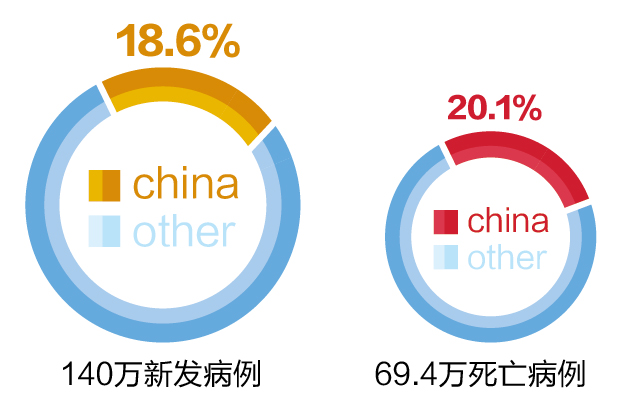< 返回肿瘤易感检测列表
 疾病相关知识
疾病相关知识
 预防
预防
 高危人群
高危人群
 检测的基因
检测的基因
 基因检测的局限性
基因检测的局限性
 参考文献
参考文献
结直肠癌
结直肠癌又叫大肠癌。结肠癌常发生于直肠与乙状结肠交界处, 直肠癌是指从肛门至乙状结肠交界处之间的癌。结直肠癌是男性第三位和女性第二位常见的恶性肿瘤,肠癌好发于中青年,大部分在45 岁左右,而且男女比例为 2~3: 1,因此对职场男士来说要重点预防。
我的基因检测结果
患结直肠癌的风险指数为0.90倍
人群平均风险指数:1.29倍*风险指数:是指将所有相关位点文献报道的发病风险汇总得到相对风险值,大于1表示增加风险,小于1表示降低风险。
| 基因位点 | 基因名 | 我的基因型 |
| rs6983267 | CASC8 |
GT
|
| rs3802842 | COLCA2 |
AA
|
| rs10795668 | LOC105376400 |
GA
|
| rs12953717 | SMAD7 |
CT
|
| rs961253 | 基因间 |
CC
|
| rs4444235 | 基因间 |
TT
|
| rs4779584 | 基因间 |
TT
|
注:绿色表示该位点检测到的基因型降低疾病风险,是保护因素,蓝色表示检测到的基因型不影响疾病风险,红色表示检测到的基因型增加疾病风险,是危险因素。
 疾病相关知识
疾病相关知识60% 的结直肠癌病例发生在发达国家,其具有明显的地域分布差异性, 其发病率高低可达 25 倍 1。我国原属于结直肠癌低发国家,但近年来, 大肠癌的发病率在中国呈逐年上升趋势。根据 WHO 发布的《World Cancer Report 2014》统计数据显示, 2012 年全球共有 140 万新发病例和 69.4 万死亡病例,中国占其中的 18.6%和 20.1%。
由于肠癌主要跟生活习惯和饮食有关。大肠癌的发生与高脂肪低纤维素饮食、大肠慢性炎症、大肠腺瘤、这些外因与个人的遗传因素相互作用而改变每个人的发病几率。绝大多数大肠癌呈散发性,但是,还有约 10%~15%的大肠癌有遗传背景,其中家族性腺瘤性息肉病(FAP)约占 1%~2%,遗传性非息肉病性大肠癌约占 2%~7%,其它还有黑斑息肉病和少年息肉病等。亲属中有大肠癌患者的人,患此病的危险性比普通人大 3~4 倍,如果家族中有两名或以上的近亲(父母或兄弟姐妹)患大肠癌,则为大肠癌的高危人群。

 预防
预防
1. 防止便秘,保持大便通畅可降低其危险性。
2. 多吃水果、蔬菜新鲜水果、蔬菜中富含维生素,其中维生素 C 具有解毒功能,可以增强抗癌能力。
3. 含膳食纤维食物的摄入可降低其危险性,纤维可稀释排泄物,减少其排泄时间和增加便重。
4. 大蒜和其中所含的一些烯丙基硫化物具有抗癌作用,动物实验显示,烯丙基硫化物可有效抑制结肠癌的形成,烯丙基硫化物能够抑制细胞生长。
5. 增加硒摄入可降低结直肠癌的危险性。
2. 多吃水果、蔬菜新鲜水果、蔬菜中富含维生素,其中维生素 C 具有解毒功能,可以增强抗癌能力。
3. 含膳食纤维食物的摄入可降低其危险性,纤维可稀释排泄物,减少其排泄时间和增加便重。
4. 大蒜和其中所含的一些烯丙基硫化物具有抗癌作用,动物实验显示,烯丙基硫化物可有效抑制结肠癌的形成,烯丙基硫化物能够抑制细胞生长。
5. 增加硒摄入可降低结直肠癌的危险性。
6. 维生素 D 和钙均为细胞生长抑制因素,两者均可诱导肠细胞的分化和凋亡,而且钙介导的作用很大程度上受维生素 D 水平的影响。钙是一种重要的营养素;细胞内的钙是许多细胞发挥作用的常见第二信使。钙对结直肠的正常细胞和肿瘤细胞具有抑制生长、诱导分化和凋亡等直接作用。
7. 持续适度的身体活动可提高代谢率和增加最大氧摄取。长期规律的这种身体活动可增加身体代谢效率和能力,并且降低血压和胰岛素耐受。而且身体活动可增加胃肠道的蠕动。
 高危人群
高危人群
1. 30~40 岁以上有消化道症状者。
2. 有大肠癌癌前病变如腺瘤、溃疡性结肠炎、血吸虫病者。
3. 有癌家族史、家族性息肉病史、遗传性结肠病者。
4. 有盆腔放疗史者。
5. 有胆囊或阑尾切除史者
2. 有大肠癌癌前病变如腺瘤、溃疡性结肠炎、血吸虫病者。
3. 有癌家族史、家族性息肉病史、遗传性结肠病者。
4. 有盆腔放疗史者。
5. 有胆囊或阑尾切除史者
 检测的基因
检测的基因
CCAT2 :肠癌相关转录子 2, 是在结肠癌发现的一个长链非编码 RNAs (lncRNA)。lncRNA是长度大于 200nt 的 RNA 分子,不编码蛋白质。目前 lncRNA 已成为研究热点,文献表明 lncRNA 与多种肿瘤的发生发展有着密切的关系,起到重要的调控作用,例如同源异型框基因反义基因间 RNA(HOTAIR)、生长停滞特异性转录本 5(GAS5)、肺癌转移相关转录本 1(MALAT1)等。一些表达异常的 lncRNA 对肿瘤的诊断、治疗和判断预后都有重要价值。
COLCA1 :编码一种位于颗粒结构的跨膜蛋白,这些颗粒结构包括晶体嗜酸性颗粒和其他颗粒状细胞器。
SMAD :编码的蛋白是目前发现的 TGFβ 家族受体激酶的关键作用底物,广泛分布在果蝇及各种哺乳动物细胞中。 Smad7 是转化生长因子-β(TGF-β)信号转导通路的抑制元件,可选择性抑制 TGF-β 信号转导通路。而 TGF-β 信号转导通路的异常同结肠直肠癌等多种肿瘤的发生有关。
COLCA1 :编码一种位于颗粒结构的跨膜蛋白,这些颗粒结构包括晶体嗜酸性颗粒和其他颗粒状细胞器。
SMAD :编码的蛋白是目前发现的 TGFβ 家族受体激酶的关键作用底物,广泛分布在果蝇及各种哺乳动物细胞中。 Smad7 是转化生长因子-β(TGF-β)信号转导通路的抑制元件,可选择性抑制 TGF-β 信号转导通路。而 TGF-β 信号转导通路的异常同结肠直肠癌等多种肿瘤的发生有关。
 基因检测的局限性
基因检测的局限性• 该检测无法包括所有与该特征相关的位点
• 基因只是影响性状的一部分因素,其他可能的因素包括成长环境和个人选择等
• 该结果解读不能作为医疗诊断依据
• 基因只是影响性状的一部分因素,其他可能的因素包括成长环境和个人选择等
• 该结果解读不能作为医疗诊断依据
 参考文献
参考文献
1. Parkin DM, Bray F, et al. Global Cancer Statistics, 2002. CACancer J Clin. 2005, 55(2): 74-108.
2. Xie J, Itzkowitz SH. Cancer in inflammatory bowel disease. World J Gastroenterol, 14: 378–389.
3. English DR, Maclnnis RJ, et al. Red meat, chicken, and fish consumption and risk of colorectal cancer. Cancer Epidemiol Biomarkews Prev. 2004; 13; 1509-14.
4. Pischon T, Lahmann PH, et al. Body Size and Risk of Colon and Rectal cancer in the European Prospective Investigation Into Cancer and Nutrition(EPIC). J Natl Cancer Inst. 2006; 98: 920-31.
5. Ruder EH, Thiebaut AC, et al. Adolescent and mid-life diet: risk of colorectal cancer in the NIH-AARP Diet and Health Study, Am J Clin Nutr.2011; 94(6): 1607-19.
6. Huang X. Iron overload and its association with cancer risk in humans: evidence for iron as a carcinogenic metal. Mutation research. 2003; 533: 153-71.
7. Tashiro N, Budhathoki S, et al. Constipation and colorectal cancer risk: the Fukuoka Colorectal Cancer Study, Asian Pac J Cancer Prev.2011; 12(8): 2025-30.
8. Park Y, Spiegelman D, et al. Intakes of vitamins A,C, and E and use of multiple vitamin supplements and risk of colon cancer: a pooled analysis of prospective cohort studies, Cancer Causes Control. 2010; 21(11): 1745-57.
9. Terry P, Giovannucci E, et al. Fruit, vegetables, dietary fiber and risk of colorectal cancer. J Natl Cancer Inst. 2001; 93: 525-33.
10. Milner JA. Preclinical perspectives on garlic and cancer. J Nutr 2006; 136: 827S-31S.
11. Milde D, Novak O, et al. Serum levels of selenium, manganese, copper, and iron in colorectal cancer patients. Biol Trace Elem Res 2001; 79: 107-14.
12. Lin J, Zhang SM, et al. Intakes of calcium and vitamin D and risk of colorectal cancer in women. Am J Epidemiol. 2005; 161:755-64.
13. Lamprecht SA, Lipkin M. Cellular mechanisms of calcium and vitamin D in the inhibition of colorectal carcinogenesis. Ann N Y Acad Sci. 2001; 952: 73-87.
14. Nilsen TI, Vatten LJ. Prospective study of colorectal cancer risk and physical activity, diabetes, blood glucose and BMI: exploring the hyperinsulinaemia hypothesis. Br J Cancer 2001; 84: 417-22.
2. Xie J, Itzkowitz SH. Cancer in inflammatory bowel disease. World J Gastroenterol, 14: 378–389.
3. English DR, Maclnnis RJ, et al. Red meat, chicken, and fish consumption and risk of colorectal cancer. Cancer Epidemiol Biomarkews Prev. 2004; 13; 1509-14.
4. Pischon T, Lahmann PH, et al. Body Size and Risk of Colon and Rectal cancer in the European Prospective Investigation Into Cancer and Nutrition(EPIC). J Natl Cancer Inst. 2006; 98: 920-31.
5. Ruder EH, Thiebaut AC, et al. Adolescent and mid-life diet: risk of colorectal cancer in the NIH-AARP Diet and Health Study, Am J Clin Nutr.2011; 94(6): 1607-19.
6. Huang X. Iron overload and its association with cancer risk in humans: evidence for iron as a carcinogenic metal. Mutation research. 2003; 533: 153-71.
7. Tashiro N, Budhathoki S, et al. Constipation and colorectal cancer risk: the Fukuoka Colorectal Cancer Study, Asian Pac J Cancer Prev.2011; 12(8): 2025-30.
8. Park Y, Spiegelman D, et al. Intakes of vitamins A,C, and E and use of multiple vitamin supplements and risk of colon cancer: a pooled analysis of prospective cohort studies, Cancer Causes Control. 2010; 21(11): 1745-57.
9. Terry P, Giovannucci E, et al. Fruit, vegetables, dietary fiber and risk of colorectal cancer. J Natl Cancer Inst. 2001; 93: 525-33.
10. Milner JA. Preclinical perspectives on garlic and cancer. J Nutr 2006; 136: 827S-31S.
11. Milde D, Novak O, et al. Serum levels of selenium, manganese, copper, and iron in colorectal cancer patients. Biol Trace Elem Res 2001; 79: 107-14.
12. Lin J, Zhang SM, et al. Intakes of calcium and vitamin D and risk of colorectal cancer in women. Am J Epidemiol. 2005; 161:755-64.
13. Lamprecht SA, Lipkin M. Cellular mechanisms of calcium and vitamin D in the inhibition of colorectal carcinogenesis. Ann N Y Acad Sci. 2001; 952: 73-87.
14. Nilsen TI, Vatten LJ. Prospective study of colorectal cancer risk and physical activity, diabetes, blood glucose and BMI: exploring the hyperinsulinaemia hypothesis. Br J Cancer 2001; 84: 417-22.
 我的购物车
我的购物车


